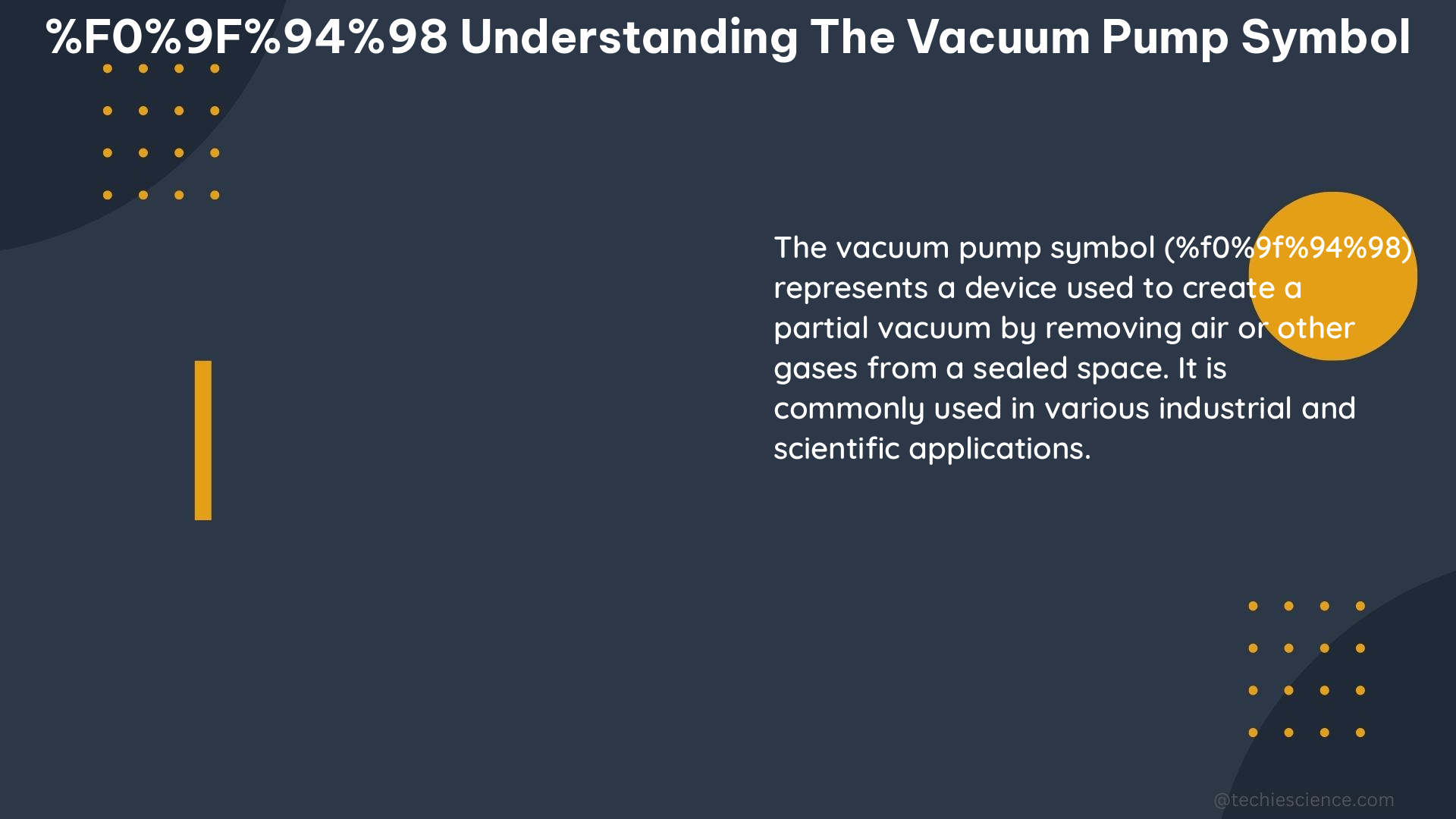The vacuum pump symbol is a crucial element in vacuum technology diagrams, providing a visual representation of the various components and their functions within a vacuum system. Understanding these symbols is essential for anyone working with vacuum pumps, as they offer a concise and standardized way to communicate the layout and functionality of a pumping system.
Vacuum Pump Types and Their Symbols
Vacuum pumps come in a variety of types, each with its unique symbol that represents the pump’s key components and characteristics. Let’s explore the most common vacuum pump types and their corresponding symbols:
-
Rotary Vane Pumps: Represented by a symbol that features a circular housing with a series of vanes or blades rotating within it. The symbol typically includes an inlet and an outlet, as well as an indication of the pump’s power source, which can be either an electric motor or a belt-driven mechanism.
-
Turbomolecular Pumps: Depicted by a symbol that resembles a turbine, with a series of blades or rotors arranged in a circular pattern. The symbol often includes an inlet and an outlet, as well as an indication of the pump’s power source, which is typically an electric motor.
-
Diffusion Pumps: Represented by a symbol that features a conical or cylindrical shape, with an inlet and an outlet. The symbol may also include an indication of the pump’s heating element, which is essential for the operation of a diffusion pump.
-
Oil-Free Pumps: Symbolized by a variety of shapes, depending on the specific type of oil-free pump. These may include dry scroll pumps, dry diaphragm pumps, or dry screw pumps, each with its own unique symbol that represents the pump’s key components and operating principles.
Vacuum Valve Symbols

Vacuum valves are essential components in vacuum systems, used to control the flow of gases and maintain the desired pressure levels. The symbols for vacuum valves represent their function and operating characteristics:
| Valve Type | Symbol |
|---|---|
| On/Off Valve | A simple rectangle or square, with an arrow indicating the direction of flow |
| Throttle Valve | A rectangle or square with a constriction in the middle, representing the valve’s ability to regulate the flow |
| Gate Valve | A rectangle or square with a vertical line in the middle, representing the valve’s gate mechanism |
| Angle Valve | A symbol that resembles a bent pipe, indicating the valve’s ability to change the direction of flow |
Vacuum Connection Symbols
Connections between vacuum components are represented by specific symbols that provide information about the type, size, and material of the connection:
- Flanges: Represented by a circle or rectangle with a series of small circles or dots around the perimeter, indicating the bolt holes used to secure the flange.
- Unions: Symbolized by a pair of parallel lines, with an arrow or other indication of the connection type (e.g., a threaded union, a compression union).
- Vacuum Fittings: Depicted by a variety of shapes and symbols, depending on the specific type of fitting (e.g., a Swagelok fitting, a KF flange).
Vacuum Gauge Symbols
Vacuum gauges are used to measure the pressure within a vacuum system, and their symbols indicate the type of gauge and its measurement range:
- Pirani Gauges: Represented by a symbol that features a Wheatstone bridge-like configuration, indicating the gauge’s thermal conductivity principle.
- Ion Gauges: Symbolized by a symbol that includes an ionization chamber, representing the gauge’s ability to measure pressure through the ionization of gas molecules.
- Cold Cathode Gauges: Depicted by a symbol that features a cylindrical or conical shape, representing the gauge’s cold cathode design.
Vacuum Pump Symbol Positioning
The positioning of vacuum pump symbols within a diagram is crucial, as it reflects the pressure gradient within the vacuum system. The general rule is that the side of the symbol with the constriction should be allocated to the higher pressure side of the system. This arrangement ensures that the symbols accurately represent the flow of gases and the pressure changes throughout the vacuum system.
Conclusion
The vacuum pump symbol is a powerful tool for understanding and communicating the layout and functionality of vacuum systems. By familiarizing yourself with the various symbols and their technical specifications, you can effectively interpret vacuum technology diagrams and ensure the proper design, installation, and operation of your vacuum pumping system.
Reference:
1. Leybold’s Glossary of Vacuum Technology Diagrams
2. Southern California Edison’s 2006-2008 Energy Efficiency Program
3. Dean’s Analytical Chemistry Handbook

The lambdageeks.com Core SME Team is a group of experienced subject matter experts from diverse scientific and technical fields including Physics, Chemistry, Technology,Electronics & Electrical Engineering, Automotive, Mechanical Engineering. Our team collaborates to create high-quality, well-researched articles on a wide range of science and technology topics for the lambdageeks.com website.
All Our Senior SME are having more than 7 Years of experience in the respective fields . They are either Working Industry Professionals or assocaited With different Universities. Refer Our Authors Page to get to know About our Core SMEs.